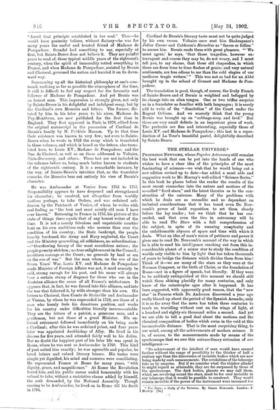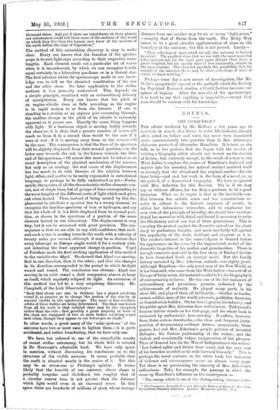THE STELLAR UNI V ERSE.* PROFESSOR NEWCOMB, whose Popular Astronomy
still remains the best work that can be put into the hands of one who wishes to have a clear idea of the principles of the most fascinating of sciences—we wish that he would bring out a new edition revised up to date—has added a most able and suggestive work to Mr. Murray's well-edited " Science Series."
In this book he places before the reader the results of the most recent researches into the nature and motions of the so-called " fixed stars," and the latest theories as to the con- struction of the universe. Many of the problems with which he deals are so recondite and so dependent on technical considerations that it has taxed even Dr. New- comb's power of lucid exposition to set them clearly before the lay reader ; but we think that he has suc- ceeded, and that even the tiro in astronomy will be
able to read The Stars with a full comprehension of the subject, in spite of its amazing complexity and the unfathomable abysses of space and time with which it
deals. What an idea of man's union of pettiness and power it gives one to read Dr. Newcomb's account of the way in which he is able to send his intelligence reaching out from this in- considerable planet of a minor star to study the condition of worlds only visible to him by light that has taken thousands of years to bridge the distance which divides them from him !
Think of it—we see many of the stars as they were at the Norman Conquest, or the birth of Christ, or the foundation of Rome—not in a figure of speech, but literally. If they were to be suddenly extinguished at this moment we should still
watch them shining placidly for many centuries, and only know of the catastrophe ages after it happened. It has
been suggested, with apparently good reason, that the "new star" in Perseus which Dr. Anderson discovered a year ago really blazed up about the period of the Spanish Armada; only it is so far away that the news has taken three centuries to reach us, travelling without rest on the wings of light, at a hundred and eighty-six thousand miles a second. And yet we are able to tell a good deal about the motions and the chemical composition of bodies which swim in the void at this inconceivable distance. That is the most surprising thing, to our mind, among all the achievements of modern science. It is, of course, to the measurements made by means of the spectroscope that we owe this extraordinary extension of our intelligence :—
"No achievement of the intellect of man would have seemed farther without the range of possibility to the thinker of half a century ago than the discoveries of invisible bodies which are now being made by such measurements. The revelations of the telescope take us by surprise. But if we consider what the thinker alluded to might regard as attainable, they are far surpassed by those of the spectroscope. The dark bodies, planets we may call them, which are revolving round the stars, must be for ever invisible in any telescope that it would be possible to construct. They would remain invisible if the power of the instrument were increased ten • The Stars : a Study of the Universe. By Simon Newcomb. London : T. Murray. [6a.]
thousand times. And yet if there are inhabitants oh these planets our astronomers could tell them more of the motions of the world on which they live than the human race knew of the motions of the earth before the time of Copernicus."
The method of this astonishing discovery is easy to make clear. Every one knows that the function of the spectro- scope is to sort light-rays according to their respective wave- lengths. Each element sends out a particular set of waves when it is incandescent, by which we can recognise it with equal certainty in a laboratory gas-flame or in a distant star. The first advance which the spectroscope made in our know- ledge was to tell us the chemical constitution of the sun and the other stars. Its later application to the stellar motions is less generally understood. This depends on a simple principle, combined with an extraordinary delicacy of manipulation. Every one knows that the pitch of an engine-whistle rises or falls according as the engine is in rapid motion to or from the listener. If one is standing in a station as an express goes screaming through, the sudden change in the pitch of its whistle is extremely apparent as it passes one. Exactly the same thing happens with light. If a luminous object is moving bodily towards the observer, it is clear that a greater number of waves will reach us from it in a second than would be the case if it were at rest : if it is moving away from us the reverse will be the case. The consequence is that the lines of its spectrum will be slightly displaced from their normal position,—in the latter case towards the red, in the former towards the blue, end of the spectrum.—Of course this must not be taken as an exact description of the physical mechanism of the process, but only as an analogy: the real cause of the displacement has too much to do with theories of the relation between light, ether, and matter to be easily expounded in untechnical language, or perhaps to be fully understood as yet.—Fortu- nately, the spectra of all the characteristic stellar elements con- sist, not of single lines, but of groups of lines corresponding to the wave-lengths of the different sorts of light which each gives out when heated. Thus, instead of being misled by this dis- placement to attribute a spectral line to a wrong element, we recognise the familiar spectrum of iron or hydrogen, and say that the whole of it is a little displaced from its normal posi- tion, as shown in the spectrum of a portion of the same element heated in our laboratory. The displacement is very tiny, but it can be measured with great precision. The con- sequence is that we are able to say with confidence that such- and-such a star is moving towards the earth with a velocity of twenty miles per second, although it may be so distant that every telescope in Europe might watch it for a century with- out detecting the least apparent change in position. Vogel of Potsdam made the first striking application of this method to the variable star Algol. He showed that Algol was moving, first in one direction, awn in the other; and that the changes in its direction corresponded to the period in which its light waxed and waned. The conclusion was obvious : Algol was moving in an orbit round a dark companion, almost as large as itself, which regularly eclipsed its light. An extension of this method has led to a very surprising discovery. Mr.
Campbell, of the Lick Observatory— "finds that about one star in thirteen has a planet revolving round it, so massive as to change the motion of the star by an amount visible in the spectroscope. The more or less eccentrie orbits of these bodies are being determined. The final conclusion from all his work is that isolated stars may be the exception rather than the rule: that possibly a great majority at least of the stars are composed of two or more bodies revolving round each other, though they appear in our telescopes as single."
in other words, a great many of the "solar systems " of the universe have two or more suns to lighten them,—it is quite accidental, and rather humiliating, that we have only one.
We have but referred to one of the remarkable results of recent stellar astronomy, but its whole field is covered
in Dr. Newcomb's admirable book. We have only space to mention, without discussing, his conclusions as to the structure of the visible universe. It seems probable that the earth is situated nearly in the centre of it. Yet this may be as erroneous as Ptolemy's opinion. It seems likely that the breadth of our universe, whose shape is probably irregular and ill-defined, but roughly that of a circular convex lens, is not greater than the distance which light would cross in six thousand years. In this space there are hundreds of millions of stars, whose average distance from one another may be six or seven " light-years," —roughly that of Sirius from the earth. The Milky Way seems to be a great circular agglomeration of stars on the boundary of the universe; but this is not proved. Lastly— "That collection of stars which we call the universe is limited in extent. The smallest stars that we see with the most powerful telescopes are not, for the most part, more distant than those a grade brighter, but are mostly stars of less luminosity, situate in the same regions. This does not preclude the possibility that far outside of our universe there may be other collections of stars of which wo know nothing."
Perhaps some day a new means of investigation, like Mr.
Wells's sympathetic crystal or the methods which the Society for Psychical Research studies, will still further increase our sphere of inquiry. After the marvels of the spectroscope, it is hard to say that anything is impossible,— except that man should be content with his knowledge.











































 Previous page
Previous page